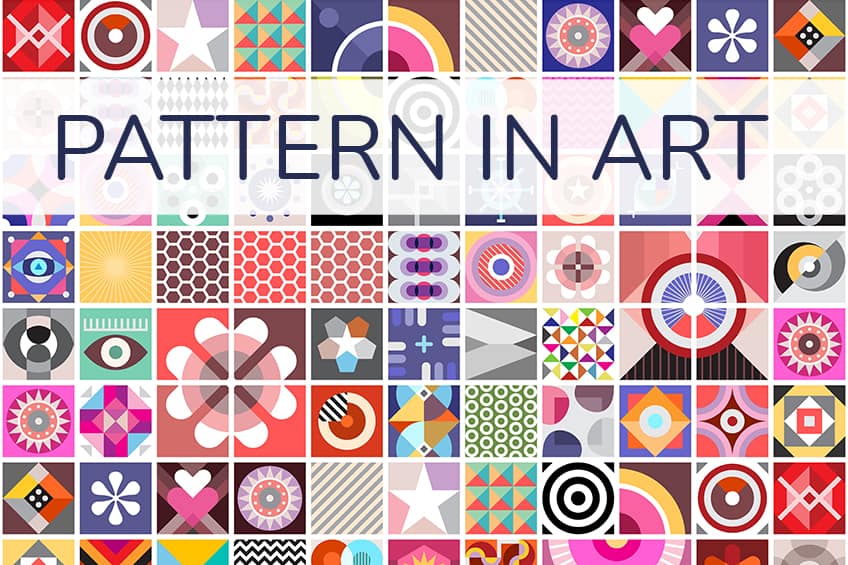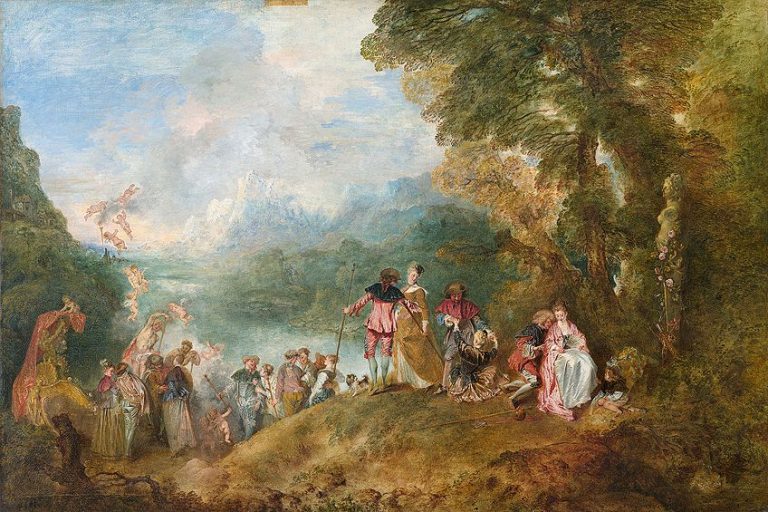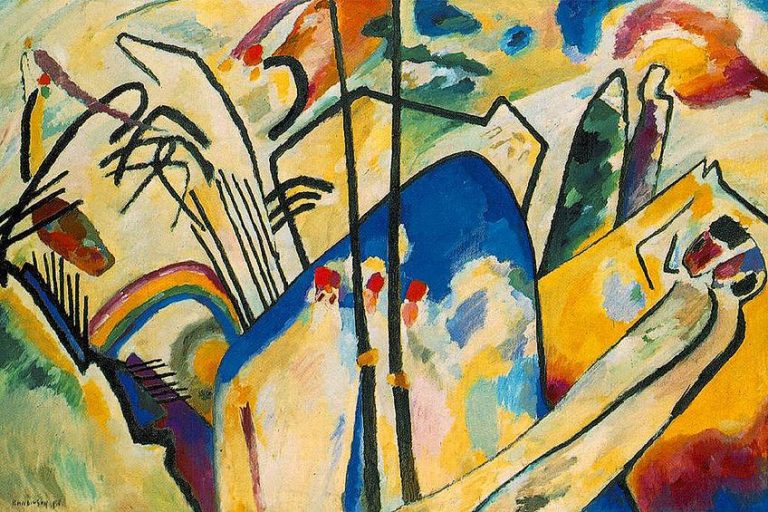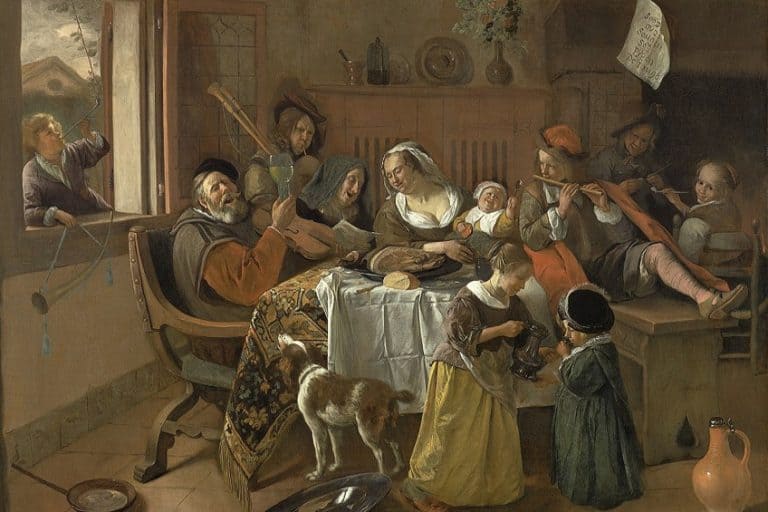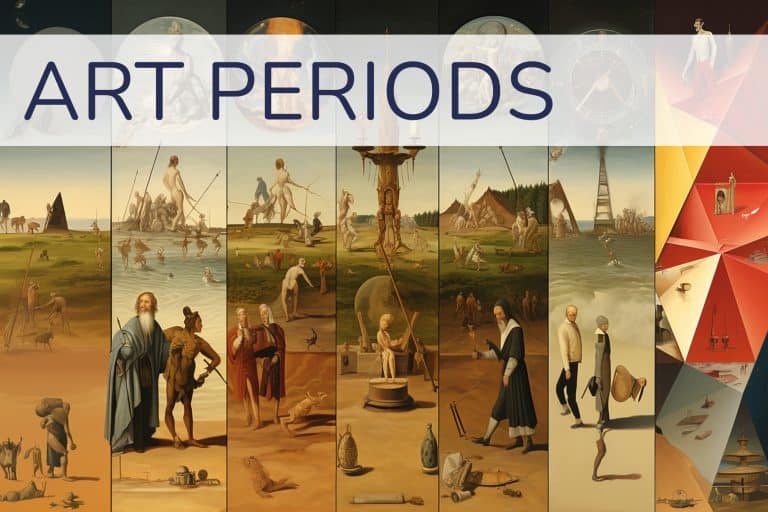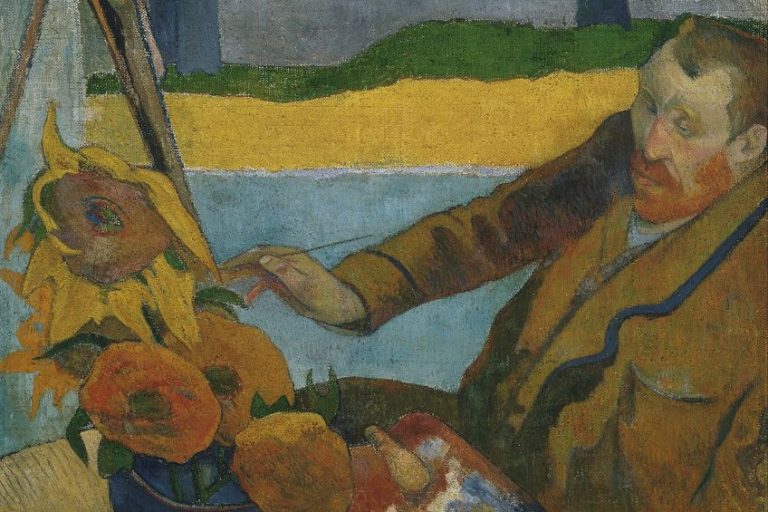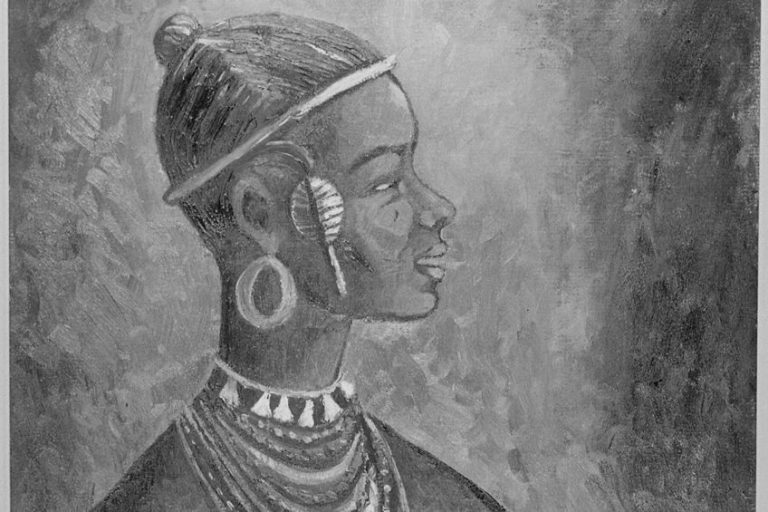Pattern in Art – Complete Guide and All Types of Patterns
There are patterns almost everywhere you look, the world is filled with them, but what are patterns, and what makes them important in art? This is the topic we will explore in the article below, providing examples of patterns in art.
What Are Patterns?
Patterns have to do with repetition, arrangements, and sequences and can be seen in natural and urban environments. From the mossy patches on tree bark, the row of windows on a skyscraper, the whorls of a seashell, to the swirls of paint on a Vincent van Gogh painting!

Patterns are created through the arrangement of shapes, forms, or lines, which are sometimes known as the term “motifs”, and can be either deliberate or natural. In art, patterns can occur in sequential order or progression to create rhythm, movement, visual appeal, or emphasis.
However, patterns can also be in other disciplines like mathematics, engineering, architecture, literature, music, and different cultures from all over the world utilize patterns to decorate important objects like masks, textiles, sculptures, and even themselves through body art.
Types of Patterns
As mentioned above, the two main types of patterns occur naturally or artificially/deliberately, in other words as some sources describe: “natural” and “man-made”. These types of patterns can be arranged in symmetric, asymmetric, geometric, organic, regular, or irregular sequences. Furthermore, patterns can appear as tiles or tessellations, waves, spirals, crisscrosses, curls, loops, rows, lines, zigzags, florals, dots, blocks, and more!
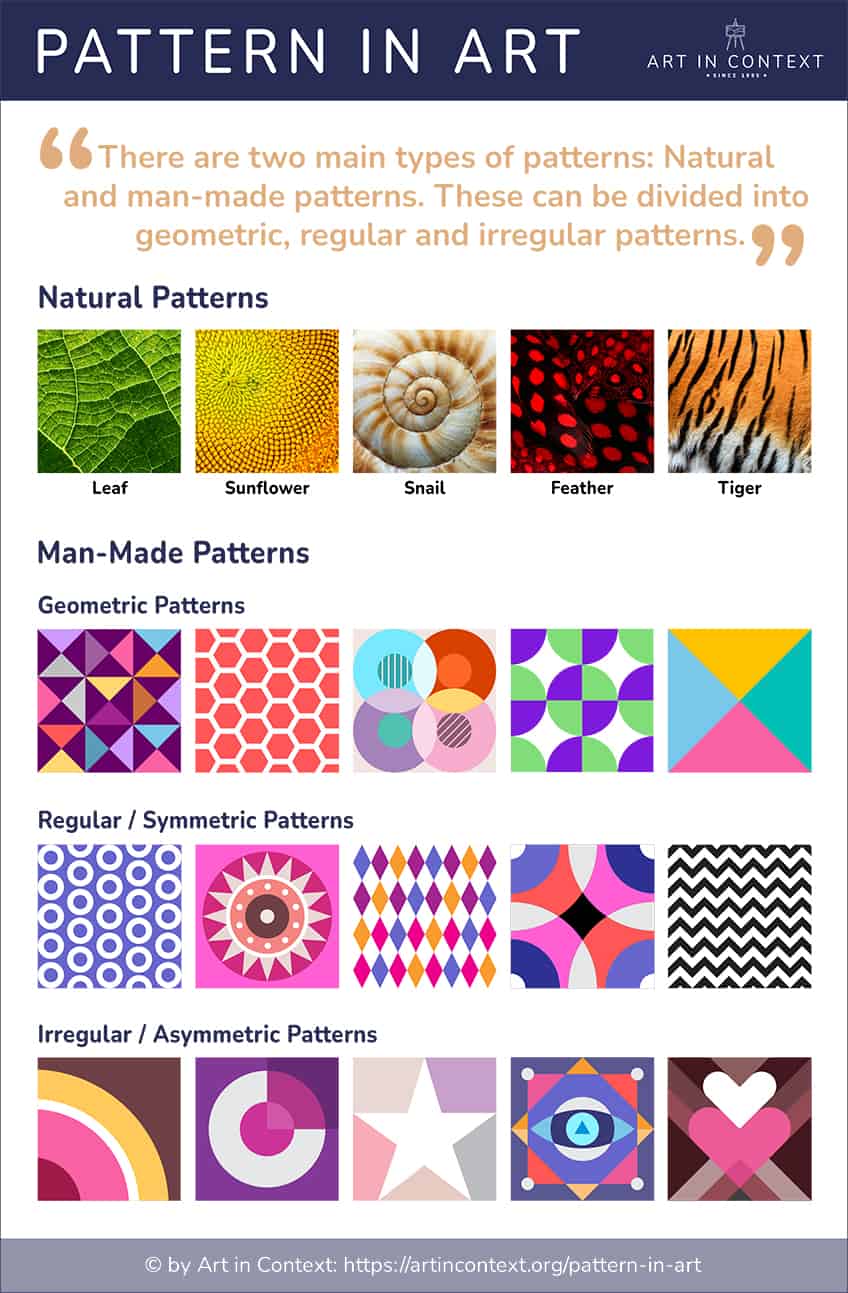
The repetitions can also come in varying shapes, sizes, and directions. For example, patterns can move outwards from a central area, they can move from left to right, up or down, and diagonally.
How Patterns Are Utilized in Art
Now that you understand what patterns are and their role as a principle of art, how can you utilize and apply pattern in art? Firstly, art patterns can be created with any of the art elements, and it all depends on the aim of the visual composition and what its purpose is. There are endless possibilities when it comes to creating art patterns.
Below, we will look at how art patterns are created using art elements like color, shape, line, and so forth, providing examples from various artists throughout art history to illustrate how the types of pattern in art have been applied.
It is also interesting to note that more than one art element can be utilized in a pattern, for example, the same shapes may be arranged in regular patterns, but be in irregular colors or vice versa.
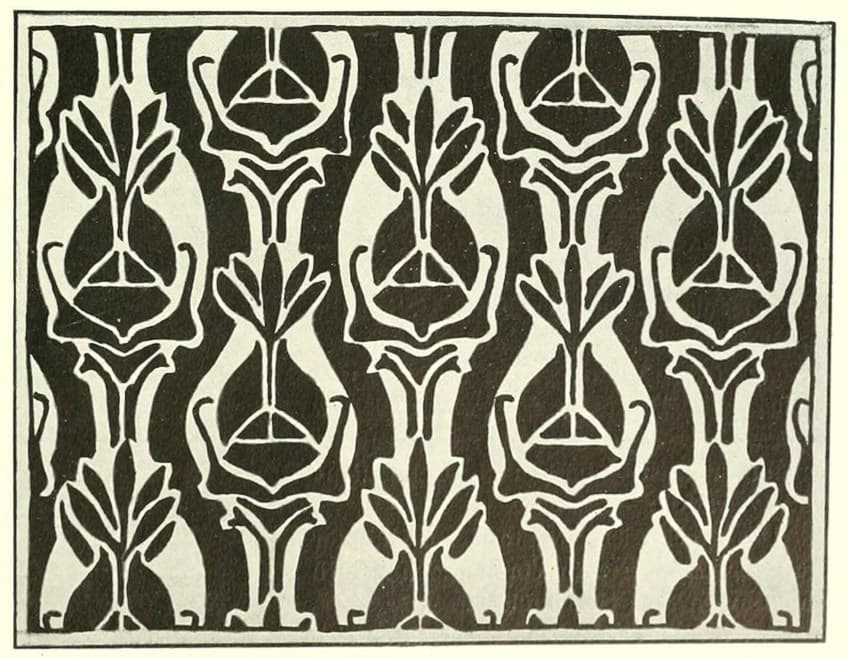
Patterns and Color
Colors can be utilized to create patterns, from monochromatic to multicolor. Furthermore, colors can be arranged in such a way that creates shapes like circles, squares, or rectangles. Colors can evoke different feelings and ideas, simply be decorative, or transcend the boundaries of the figurative.
The Color Field Painting art movement within Abstract Expressionism is one example of how pattern in art is created by large areas of colors.
Color is often described as being the subject matter of the painting from this style, coupled with various shapes. Additionally, colors were also applied on “flat” surfaces that are usually also described as “large fields” of color.
An example of how a pattern in artwork from the Color Field Painting art style is created includes Shoot (1964) by Kenneth Noland. Here, we see an inverted triangular shape consisting of four bands of color. Although there is an emphasis on shape here too, it works closely alongside color, and we see how colors equally create the geometric patterns.
Patterns in Texture
Texture in visual arts can either be implied/illusional or tactile, created by the physical medium itself like paint and the brushstrokes on a canvas. Brushstrokes can also create patterns on the canvas and become part of the composition. An example of how pattern in artwork is created through brushstrokes and texture can be found in the famous and loved The Starry Night (1889) painting by Vincent van Gogh.
The brushstrokes composing the sky, the landscape, and the looming cypress tree in the left foreground, all appear similar, creating a dynamic pattern.
We can see the swirls of paint, created by Van Gogh’s utilization of brushstrokes, composing the sky, which gives it rhythm and movement. The brushstrokes move from one direction to the other and form circular arrangements around the moon and stars.
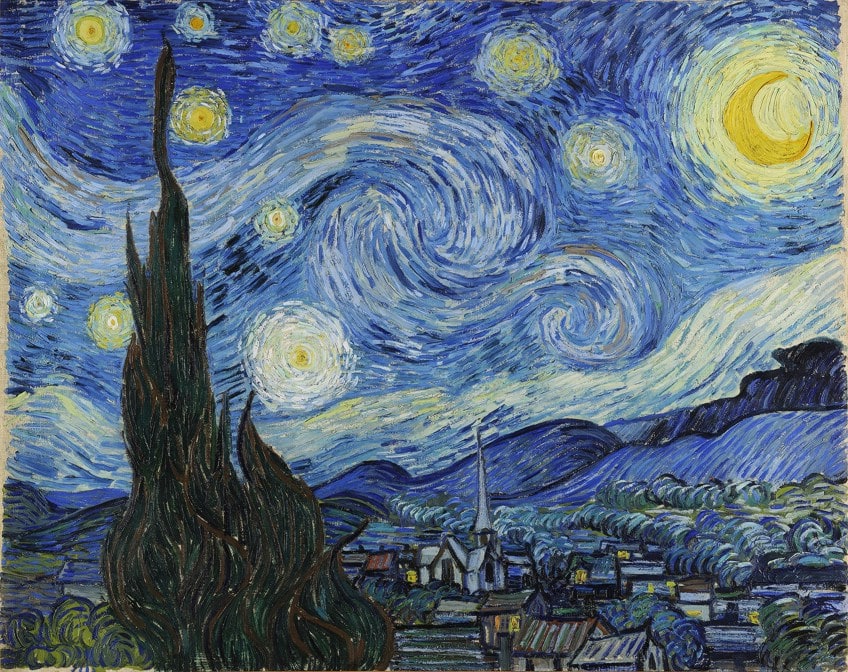
These brushstroke lines are echoed in the sloping hills in the background, and further in the landscape below that shows houses and trees. The composition becomes harmonious because of the unity of patterns created from the brushstrokes.
Jackson Pollock from Abstract Expressionism is a famous example of how physical paint splattered and streaked onto a canvas can create patterns. He was known for his so-called “drip technique” and what is known as “Action Painting”.
An example of pattern in art can be seen in Pollock’s Autumn Rhythm (Number 30) (1950) depicts drips of paint, which appear as streaks all intertwining, overlapping, and moving in every direction possible, however, the physical paint on the canvas creates a random and irregular patterned effect.
If we look at other modalities like sculpture, notably ceramics, patterns become ideal decorations. For example, we can look as far back as ancient Greek pottery, a vast world of its own depicting myriads of mythological narratives around the circumferences of vessels utilized for everyday activities. An example of this includes the François Vase (ca. 570 – 565 BCE), which was painted by the Athenian known as Kleitias and the potter was Ergotimos.
This vase was found by the archaeologist Alessandro François, after whom it was named.
It depicts various mythological narratives, from gods to heroes, all arranged around the vase in what is known as “friezes”. Although the friezes depict different events occurring around the vase, there is still a pattern, albeit irregular, created.
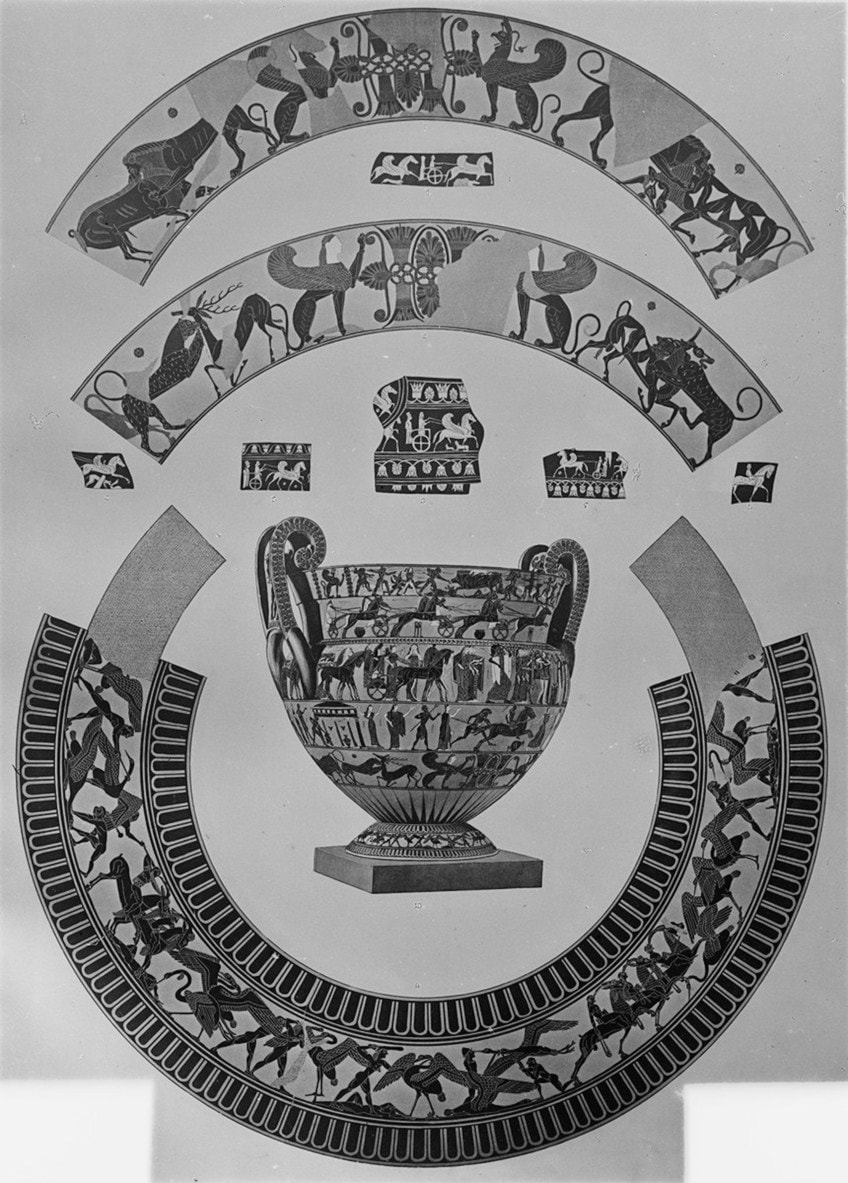
Patterns in Shapes and Forms
Shapes and forms are often utilized to create patterns and there are almost endless possibilities when it comes to how these can be arranged or sequenced. Shapes can be anything from squares, rectangles, circles, triangles, ovals, and more.
Forms can be anything from three-dimensional shapes like spheres or cubes, but also figurative forms.
Examples of pattern in art that utilizes shape can be found in the artwork of Piet Mondrian, who was the pioneer of the art style called Neo-Plasticism, namely his Composition with Red, Blue, and Yellow (1930) where he utilizes black outlines that then form squares and rectangles on the canvas with white in between and some colored areas.
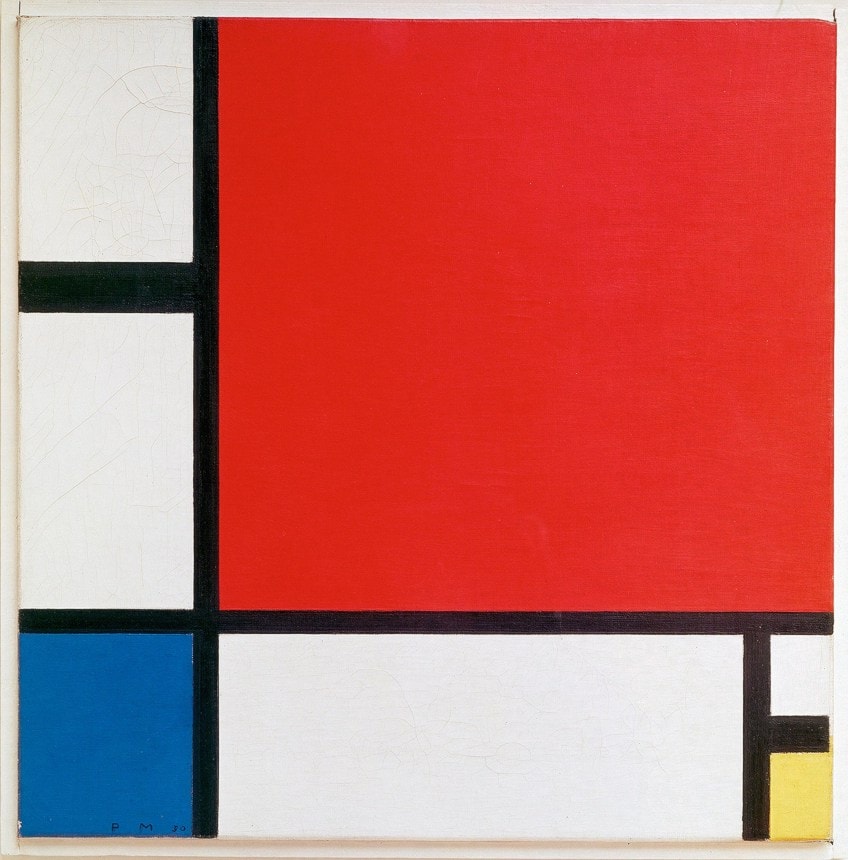
The composition appears almost as checkered patterns and the shapes are not all the same size thus creating irregular patterns. This was a common characteristic in Mondrian’s art, and we find his geometric and irregular patterning of shapes in numerous of his paintings. In one of Mondrian’s other paintings, Broadway Boogie Woogie (1942-1943), we see more square and rectangular shapes with areas of color, including white in between.
However, this arrangement appears more irregular, which ironically creates a compositional unity due to the similarity in the patterning of shapes and colors.
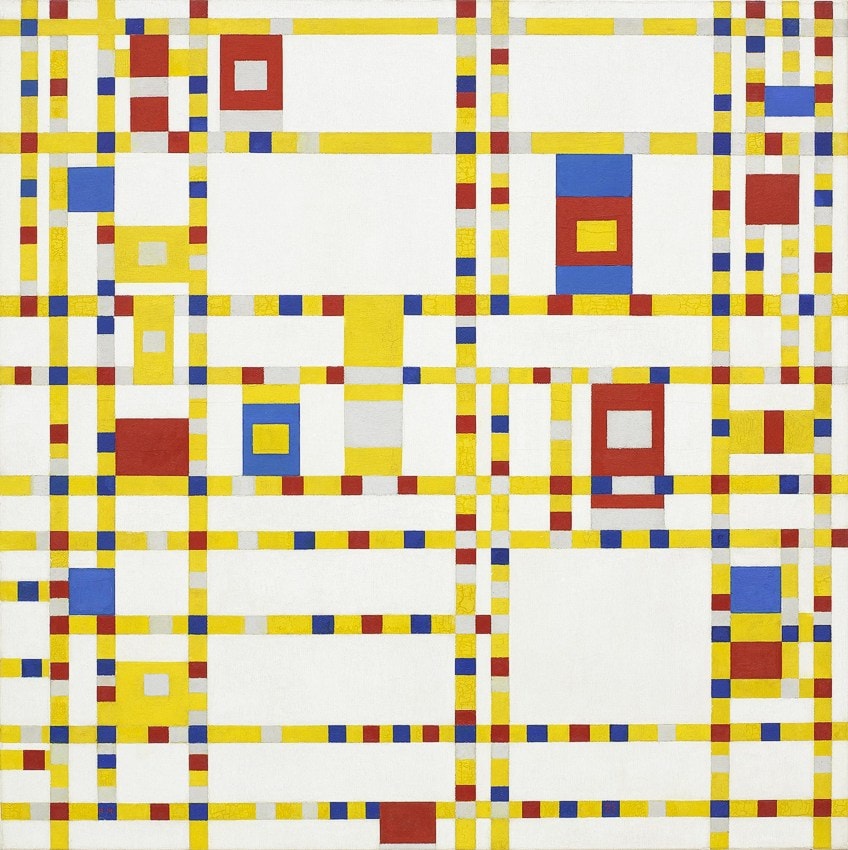
An example where shapes are depicted as a more symmetrical pattern in artwork can be seen in the paintings by Mark Rothko, who was also a Color Field painter. His Untitled, Black on Gray (1969) depicts two joined rectangles, the top is black, and the bottom is gray. You might wonder how this has anything to do with a pattern, but it illustrates how shapes are repeated and placed in a symmetrical arrangement, even just two shapes.
In other words, there is more order to it and the differences are in the colors, which give it character, but also speak to a deeper meaning that Rothko intended, that being about “death”.
The Symbolist painter Gustav Klimt is famous for his painting The Kiss (1907-1908), which depicts an assortment of shapes like rectangles, circles, and squares all arranged in patterns as decorative motifs for the subject matter. These are also evident in Klimt’s Portrait of Adele Bloch-Bauer I (1907), but it also has organic shapes like spirals and ovular eye shapes.
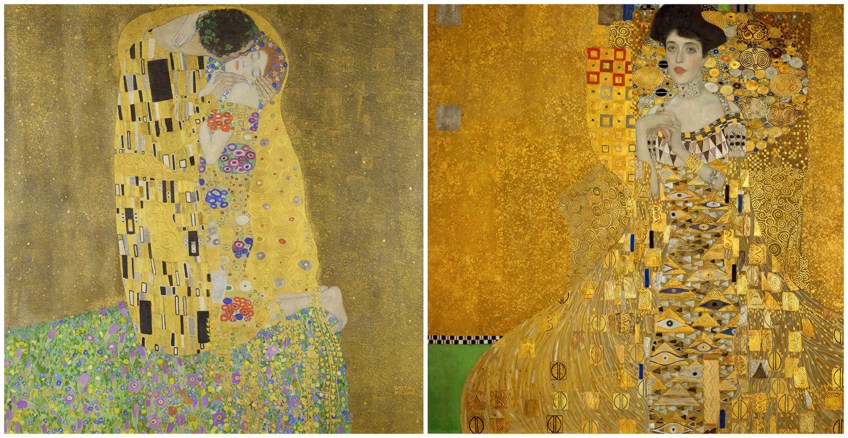
Another artist worth mentioning who employed organic forms as patterns was William Morris, who was one of the pioneers of the Arts and Crafts Movement in England during the 1800s. He was a painter, textile artist and designer, poet, and writer, among many others.
Morris was inspired by a Medieval art style and often created organic and natural designs that depicted beautiful decorative patterns.
For example, his wallpaper designs like the Larkspur Wallpaper (1874), Acanthus Wallpaper (1875), and Sunflower Wallpaper (1879); he reportedly created over 50 designs. Each design features floral and foliage-inspired motifs and appears natural in its repeated curvatures and curls. He is often quoted comparing patterns to a “fortress” and that “it is no stronger than its weakest point”.

From geometric shapes, fauna, and flora to figurative forms of famous pop stars, repeated en masse by Pop Artist Andy Warhol. The Marilyn Diptych (1962) is just one of many examples by Warhol of how he created patterns from pop culture.
In this silkscreen painting, he depicted 50 iterations of Marilyn Monroe’s portrait all arranged in horizontal rows of five; the left section is in color and the right is in black and white.
However, there cannot be a mention of Andy Warhol without mentioning his famous Campbell’s Soup Cans (1962), which consists of 32 individual canvases with the image of a Campbell Soup can painted on it (all the cans are different flavors too).
Warhol reportedly touched on mass media and the advertisement industry, of which repetition and replication are a large part.
Patterns in Lines
Bridget Riley from the Op Art movement became well-known for producing compositions that appeared like optical illusions through shapes, lines, and colors. For example, Riley’s oil on canvas Nataraja (1993) depicts bands of color, or as some describe it “stripes”, arranged in diagonal patterns, however, upon closer viewing, horizontal bands become evident and run from top to bottom of the canvas, thus also creating an optical effect.
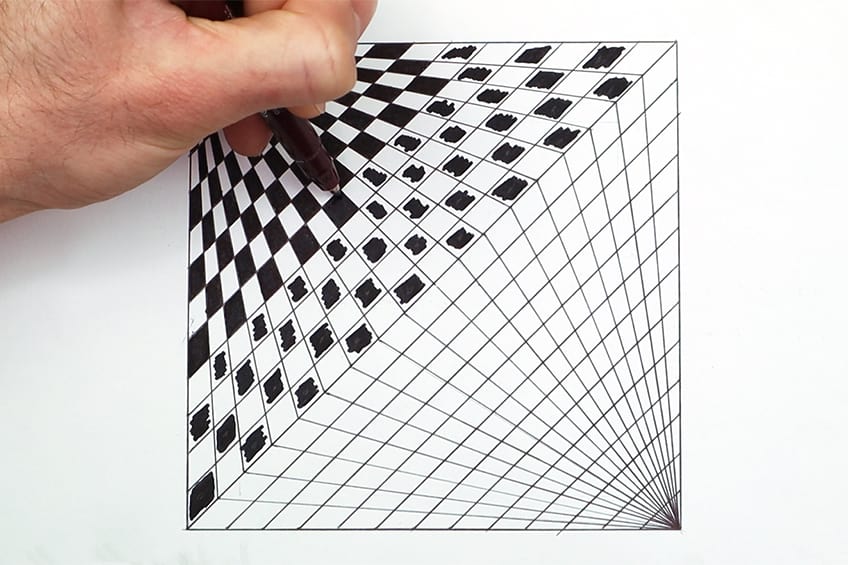
In his enamel on canvas painting The Marriage of Reason and Squalor, II (1959), which was part of his series of Black Paintings (1958-1960) the artist painted black strips or bands on the canvas with thin gaps in between, which is the canvas underneath that appear as white lines.
The shape of the composition is described as an inverted “U” and the arrangement of the black and white lines creates a patterned effect. This composition is also more geometric and symmetrical, denoting an ordered arrangement of lines.
Stella created several more from his series, also enamel on canvas, some include Jill (1959), which depicts lines in a diamond shape that starts small in the center and becomes bigger as it emanates outwards, and Zambezi (1959), which appears as a large “X” shape with open-ended triangular shapes moving outwards in each direction.
Another example of pattern in artwork with a focus on lines comes from Gene Davis, who was part of the Color Field Painting art style. He created artworks that depicted vertical lines in multi colors, for example, Hot Beat (1964), Red Witch (1966), and Dr. Peppercorn (1967).
Patterns in Space
Space as an element of art refers to the compositional space, which is described as the area that occurs “around” the main subject matter. Furthermore, space can be positive or negative, in other words, the positive space consists of the primary subject matter, or the area of focus in the composition, and negative space consists of the area around the focal point, which is sometimes “unused” but can be equally impactful in drawing attention.
Any pattern in artwork can be created through positive and negative space through the arrangement of an assortment of motifs, and some artists like M. C. Escher became famous for how he played with patterns and space, giving rise to numerous optical illusions known as his “tessellations”.

Examples include Escher’s Day and Night (1937), which depicts an aerial view of a town and a flying flock of birds in the sky. The composition is split into two mirror images; however, the left side depicts the daytime with blackbirds, which is the positive space, and the right side, the nighttime, has white birds, which is the positive space.
In Escher’s example of pattern in art, Bird Fish (1938), we see the patterned interplay between positive and negative space. Here there are rows of red/orange birds with white fish filling up the spaces around them, however, we can also say there are white fish with birds filling up the space around them – it all depends on how you look at it.
“Repetition, Repetition, Repetition”
In this article, we explored patterns as one of the Principles of Art. The types of pattern in art can be anything from geometric and structured shapes or lines to flowy, curvy, and natural forms, all arranged and repeated to create various effects.
Patterns are part of a world of artful arrangements that can have hundreds of meanings, from serving as decorations, optical illusions, or merely art for art’s sake.
However, patterns created by Andy Warhol, for example, touch on larger ideas of consumerism, and we could also go so far as to say that patterns create the means by which mass media can reproduce products or people. In other words, patterns allow for replication, one item placed next to the other, whether it is on a grocery shelf or art gallery wall. Patterns speak to the decorative as well as to the monotony of many.
While we have only outlined several prominent artists from all walks of life and art movements as examples of how patterns occur in art, we encourage you to look further, see between the lines, between the birds, around the splashes of paint, and swirls of brushstrokes and rows of images of Marilyn Monroe – patterns are everywhere, and as the adage goes, “repetition, repetition, repetition”.
Frequently Asked Questions
What Are Patterns?
Pattern in art is one of the principles of art and are motifs (consisting of shapes, lines, and forms) that are repeated in arrangements, sequences, and groupings, whether ordered horizontally, vertically, or diagonally, or more irregular and random. Patterns can create a sense of rhythm or lead to a main focal point.
What Are the Types of Pattern in Art?
There are so-called man-made patterns and natural patterns, and they can be geometric or organic. Some patterns can consist of lines, curls, spirals, animal shapes, zigzags, dots, arabesques, circles, and squares, among many others.
What Are the Principles of Art?
The principles of art are so-called organizational principles, in other words, they determine how art elements (line, color, form, texture, space, shape, and value) will be applied in a visual composition. The art principles are namely, balance, harmony, unity, scale, proportion, emphasis, variety, pattern, repetition, movement, and rhythm.
Alicia du Plessis is a multidisciplinary writer. She completed her Bachelor of Arts degree, majoring in Art History and Classical Civilization, as well as two Honors, namely, in Art History and Education and Development, at the University of KwaZulu-Natal, South Africa. For her main Honors project in Art History, she explored perceptions of the San Bushmen’s identity and the concept of the “Other”. She has also looked at the use of photography in art and how it has been used to portray people’s lives.
Alicia’s other areas of interest in Art History include the process of writing about Art History and how to analyze paintings. Some of her favorite art movements include Impressionism and German Expressionism. She is yet to complete her Masters in Art History (she would like to do this abroad in Europe) having given it some time to first develop more professional experience with the interest to one day lecture it too.
Alicia has been working for artincontext.com since 2021 as an author and art history expert. She has specialized in painting analysis and is covering most of our painting analysis.
Learn more about Alicia du Plessis and the Art in Context Team.
Cite this Article
Alicia, du Plessis, “Pattern in Art – Complete Guide and All Types of Patterns.” Art in Context. October 4, 2022. URL: https://artincontext.org/pattern-in-art/
du Plessis, A. (2022, 4 October). Pattern in Art – Complete Guide and All Types of Patterns. Art in Context. https://artincontext.org/pattern-in-art/
du Plessis, Alicia. “Pattern in Art – Complete Guide and All Types of Patterns.” Art in Context, October 4, 2022. https://artincontext.org/pattern-in-art/.


